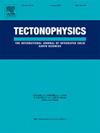Tomographic evidence for segmentation of the Main Himalayan Thrust in the Uttarakhand Himalaya
IF 2.7
3区 地球科学
Q2 GEOCHEMISTRY & GEOPHYSICS
引用次数: 0
Abstract
Imaging the Main Himalayan Thrust (MHT) along and across the strike of the Himalaya is critical to understand seismogenesis and earthquake hazard. This study investigates the 3D P and S velocity structure of the Garhwal-Kumaon Himalaya (GKH) using travel times of 846 local events recorded at 54 broadband stations. Depth sections of the velocity anomalies capture the flat-ramp-flat structure of the MHT. The MHT is expressed as a low-velocity layer, possibly due to dehydration of sediments. Also, the geometry of the MHT seems distinctly different in the Garhwal and Kumaon segments. It is steeper with a narrow width in the former and gentler with a larger width in the latter. The width of the MHT is ∼60 km in Garhwal and ∼ 85 km in Kumaon. However, if the whole MHT is assumed as a locked zone, its width from the Main Frontal Thrust to the 3.5 km elevation contour in the Higher Himalaya is ∼115 in the former and ∼ 130 km in the latter. The MHT in Garhwal has a 30 km wide shallow ramp (∼2°) in the upper flat attached to a ∼ 30° steeply dipping 10 km wide ramp, which merges with a lower flat at a depth of ∼20 km beneath the Main Central Thrust(MCT). Such a flat-ramp-flat geometry is not evident in Kumaon, with the MHT remaining flat. Also, the subsurface structures and earthquake depths beneath the MCT differ in these segments, with a varying thickness of the low-velocity layer. Relocation of earthquakes using the 3D tomographic model reveals a dominant (85–90 %) occurrence in the upper crust. The seismicity is found to straddle within a narrow zone of 30–50 km around the MCT. While the seismicity belt is mostly to the south of MCT in Kumaon, it is along and north of it in Garhwal. Deeper seismicity in Garhwal sub-Himalaya seems associated with the deep-seated Delhi Haridwar Ridge (DHR) transverse to the strike of Himalaya.

北阿坎德邦喜马拉雅主逆冲断层分割的层析成像证据
对沿喜马拉雅走向和横跨喜马拉雅走向的喜马拉雅主逆冲断层(MHT)进行成像对于了解地震成因和地震危险性至关重要。本文利用54个宽带站记录的846个本地事件的传播时间,研究了Garhwal-Kumaon喜马拉雅(GKH)的三维P和S速度结构。速度异常的深度剖面捕捉了MHT的平-斜-平结构。MHT表现为低速层,可能是由于沉积物脱水所致。此外,在Garhwal和Kumaon段,MHT的几何形状似乎明显不同。前者较为陡峭,宽度较窄,后者较为平缓,宽度较大。高铁的宽度在加尔瓦尔为~ 60公里,在Kumaon为~ 85公里。然而,如果将整个MHT假设为一个锁定带,则其从主锋面逆冲到高喜马拉雅地区3.5 km高程等高线的宽度在前者为~ 115 km,在后者为~ 130 km。Garhwal的MHT在上部平地上有一个30公里宽的浅斜坡(~ 2°),与一个10公里宽的陡倾斜斜坡相连,后者在主中央逆冲(MCT)下方约20公里处与一个较低的平地合并。这种平坦的坡道平坦的几何形状在Kumaon并不明显,MHT保持平坦。此外,MCT下的地下结构和地震深度在这些段中也有所不同,低速层的厚度也有所不同。利用三维层析模型重新定位地震显示,主要(85 - 90%)发生在上地壳。地震活动被发现横跨在MCT周围30-50公里的狭窄区域内。虽然地震活动性带主要位于Kumaon的MCT以南,但它在Garhwal的MCT沿线和北部。加尔瓦尔亚喜马拉雅地区较深的地震活动性似乎与喜马拉雅走向横向的德里哈里瓦尔脊(DHR)有关。
本文章由计算机程序翻译,如有差异,请以英文原文为准。
求助全文
约1分钟内获得全文
求助全文
来源期刊

Tectonophysics
地学-地球化学与地球物理
CiteScore
4.90
自引率
6.90%
发文量
300
审稿时长
6 months
期刊介绍:
The prime focus of Tectonophysics will be high-impact original research and reviews in the fields of kinematics, structure, composition, and dynamics of the solid arth at all scales. Tectonophysics particularly encourages submission of papers based on the integration of a multitude of geophysical, geological, geochemical, geodynamic, and geotectonic methods
 求助内容:
求助内容: 应助结果提醒方式:
应助结果提醒方式:


